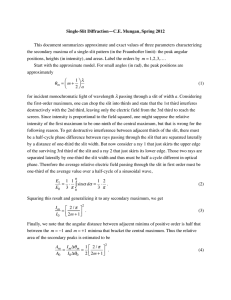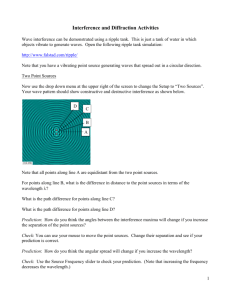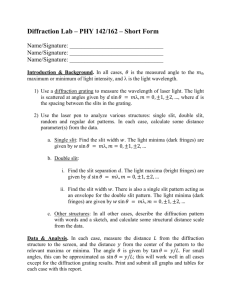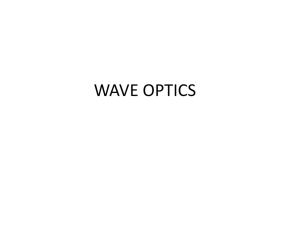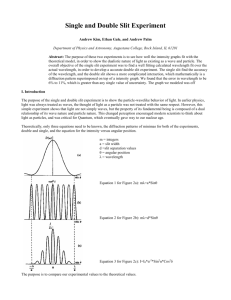Advanced Lab Diffraction and interference Palm
advertisement
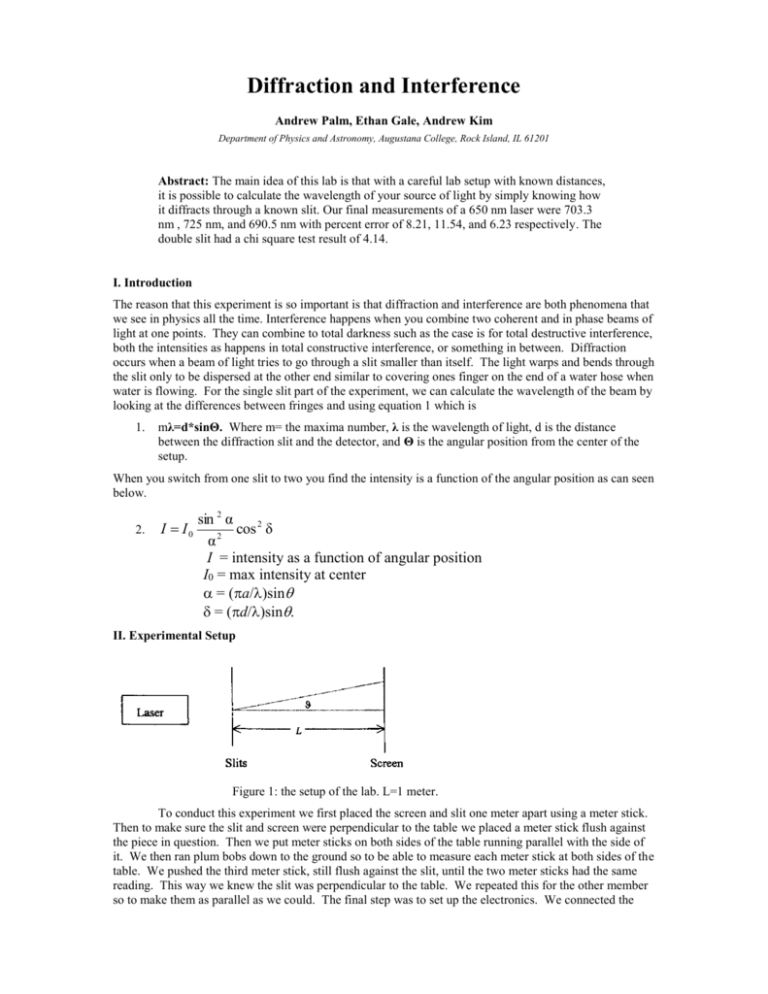
Diffraction and Interference Andrew Palm, Ethan Gale, Andrew Kim Department of Physics and Astronomy, Augustana College, Rock Island, IL 61201 Abstract: The main idea of this lab is that with a careful lab setup with known distances, it is possible to calculate the wavelength of your source of light by simply knowing how it diffracts through a known slit. Our final measurements of a 650 nm laser were 703.3 nm , 725 nm, and 690.5 nm with percent error of 8.21, 11.54, and 6.23 respectively. The double slit had a chi square test result of 4.14. I. Introduction The reason that this experiment is so important is that diffraction and interference are both phenomena that we see in physics all the time. Interference happens when you combine two coherent and in phase beams of light at one points. They can combine to total darkness such as the case is for total destructive interference, both the intensities as happens in total constructive interference, or something in between. Diffraction occurs when a beam of light tries to go through a slit smaller than itself. The light warps and bends through the slit only to be dispersed at the other end similar to covering ones finger on the end of a water hose when water is flowing. For the single slit part of the experiment, we can calculate the wavelength of the beam by looking at the differences between fringes and using equation 1 which is 1. mλ=d*sinΘ. Where m= the maxima number, λ is the wavelength of light, d is the distance between the diffraction slit and the detector, and Θ is the angular position from the center of the setup. When you switch from one slit to two you find the intensity is a function of the angular position as can seen below. 2. I I0 sin 2 α cos 2 δ α2 I = intensity as a function of angular position I0 = max intensity at center = (a/)sin = (d/)sin. II. Experimental Setup Figure 1: the setup of the lab. L=1 meter. To conduct this experiment we first placed the screen and slit one meter apart using a meter stick. Then to make sure the slit and screen were perpendicular to the table we placed a meter stick flush against the piece in question. Then we put meter sticks on both sides of the table running parallel with the side of it. We then ran plum bobs down to the ground so to be able to measure each meter stick at both sides of the table. We pushed the third meter stick, still flush against the slit, until the two meter sticks had the same reading. This way we knew the slit was perpendicular to the table. We repeated this for the other member so to make them as parallel as we could. The final step was to set up the electronics. We connected the data studio tool and set it up to read angular position and light intensity. The setup was then complete. To conduct the actual experiment, my partner slowly swept our scanner across the beam. We made a plot of light intensity versus angular position. Then we used equations 1, 2, and 3 to get our data. III. Results For the single slit, we found our experimental wavelengths for our three trials to be 703.3 nm, 725.0, and 690.5. The percent error of the these were 8.21, 11.54, and 6.23 respectively. For the double slit, we found our chi square test to be 4.14 which is far less than the number of points we used (13). IV. Discussion Our single slit measurements of 703.3 nm , 725 nm, and 690.5 nm should have been closer to the theoretical value of 650 nm.. Things that could have helped make our values closer would have been having more data points to deal with and keeping our detector and laser more parallel. We did our best keeping the detector parallel but it is not possible to keep from moving the detector slightly out of alignment when you move the detector from side to side with the setup we had. We had the same person slide the detector each time so to minimize error in that category. The number of points could have been fixed by sliding the detector slower so as to allow the detector to analyze at more points. If we were to do this experiment again we would do so. The double slit had the same sources of error as the single slit. For the 15 points we do have, the theoretical curve matches up pretty well with our points. Our Chi square test gave a value of 4.14 after throwing out one outlier. This is much smaller than the number of points we used in it (13). In that respect, I believe we did a good job. References The lab manual found at helios website http://helios.augustana.edu/~cv/351/

